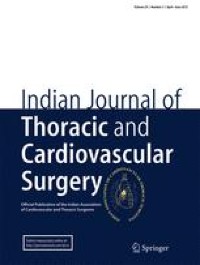Abstract
Background
Anomalous origin of coronary artery from pulmonary artery (AOCAPA), as is evident from the name, is defined as abnormal origin of either coronary artery from the pulmonary artery. The consequences vary in most cases and these anomalies lead to severe coronary hypo-perfusion and ventricular dysfunction. The common variants of this cardiac malformation are an anomalous origin of a left coronary artery from a pulmonary artery (ALCAPA) and anomalous origin of the right coronary artery from a pulmonary artery (ARCAPA). Another rare variant is left main coronary artery atresia that resembles ALCAPA in its mode of presentation. This article presents a single surgeon experience of managing this complex subset of the coronary anomaly from April 2006 to July 2019.
Material and methods
The 105 patients, who underwent surgery for AOCAPA from April 2006 to July 2019, have been included in the study. The patients have been analysed by follow-up echocardiography and electrocardiography (ECG) at our hospital by paediatric cardiologists. Out of 105 patients of AOCAPA, 98 (93.3%) patients underwent ALCAPA repair, of which 59 (60.2%) were males and 39 (39.7%) were females. Four out of five patients, who had an anomalous origin of the left coronary artery from the right pulmonary artery (ALCARPA), had an intramural aortic course. Three patients (3%) had left main coronary artery atresia and four patients (4%) had ARCAPA. It may be mentioned that seven infants (7.14%) and one adult patient (1%) underwent concomitant mitral valve repair. All the patients with ALCAPA, left main coronary artery atresia and ARCAPA, and 1 of the patients with ALCARPA, underwent coronary relocation. In four out of five patients with ALCARPA, unroofing of intra-aortic intramu ral course was performed.
Results
Out of 105 patients of AOCAPA, 9 (8.5%) patients had in-hospital mortality. Five infants (5.0%) with ALCAPA and one patient (1%) with ALCARPA died in the post-operative period due to severe left ventricular dysfunction, mitral regurgitation (MR) and sepsis. One adult patient (1%) with ALCAPA, who underwent coronary relocation using in situ trap door technique and mitral valve (MV) repair, died due to massive intracranial bleeding. Two patients out of three (66.6%) with left main coronary atresia died in intensive care unit (ICU) after 3rd and 4th postoperative day, due to low cardiac output, severe ventricular dysfunction and severe MR. Patients were followed up for a median 5.9 years. Seven patients were lost to follow-up, including the sole survivor of left main coronary atresia, after a median follow-up of 4 years after surgery. Three patients underwent mitral valve replacement for progressive residual MR. There has been no late mortality.
Conclusion
AOCAPA is a rare congenital cardiac anomaly, which usually presents in infancy with left ventricular dysfunction and mitral valve regurgitation. Early diagnosis and surgical re-establishment of the dual coronary system has given gratifying results, with improvement in left ventricular function in survivors. Mitral valve intervention for MR was required, in both early and late phases.



No comments:
Post a Comment